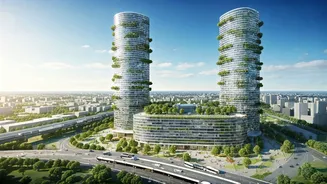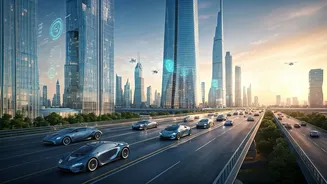Cities of Tomorrow
Many cities worldwide are at the forefront of technological and design advancements, mirroring what could be commonplace in 2050. They are characterized
by smart infrastructure, sustainable practices, and integrated technologies. These cities prioritize efficiency, convenience, and a high quality of life for their residents. Smart grids regulate energy consumption, while electric vehicle networks reduce emissions. Furthermore, these cities often feature green spaces, vertical farms, and eco-friendly buildings. This shift helps make cities more sustainable and appealing places to reside. The integration of technology affects every facet of urban life. From digital public services to advanced transportation networks, everything is designed to improve daily life. These cities also often support data-driven governance, using data to optimize resource allocation and manage urban growth effectively. With this emphasis on innovation and forward-thinking, these cities are becoming models for the future.
Smart Cities
Smart cities utilize digital technologies to enhance urban operations and services. Barcelona, Spain, is a prime example. It has deployed smart sensors for waste management, traffic control, and environmental monitoring. This approach reduces operational costs and boosts the quality of life for citizens. Similarly, Singapore has implemented a comprehensive smart nation initiative. It incorporates digital services, automated transport, and a focus on cybersecurity. Singapore’s dedication to technological integration covers nearly every aspect of its urban existence. Another notable example is Songdo, South Korea, a purpose-built smart city designed from the ground up. It features an advanced network of sensors and data analytics to create a highly efficient urban environment. These sensors gather information about everything from energy use to traffic patterns. This enables the city to respond dynamically to the requirements of its population, promoting sustainability and well-being.
Sustainable Living
The quest for sustainability is shaping urban landscapes, with many cities integrating green initiatives. Vancouver, Canada, is a leader in sustainability, emphasizing green building standards, renewable energy, and extensive public transportation networks. This commitment has allowed the city to minimize its carbon footprint and foster a cleaner, healthier urban environment. Similarly, Curitiba, Brazil, is celebrated for its innovative bus rapid transit system and expansive green spaces. The city's effective urban planning has improved its environmental sustainability while enhancing residents' lives. Another notable example is Copenhagen, Denmark, which prioritizes cycling infrastructure and renewable energy sources, thereby setting a global standard for environmental practices. These initiatives highlight the role of sustainable urban design in addressing environmental issues and fostering a higher quality of life. These cities are not only mitigating climate change but are also promoting biodiversity and enhancing community health.
Tech-Integrated Cities
Technology is being deeply woven into the infrastructure of modern cities. Dubai, UAE, exemplifies this trend, with its focus on high-tech infrastructure, including smart transportation systems and AI-driven services. The city’s emphasis on technology enhances its efficiency and allure as a global hub. Similarly, Tokyo, Japan, is renowned for its technologically advanced public transport system, along with its robotics and automation projects. Tokyo consistently leads in innovation, providing convenient and efficient solutions to urban challenges. Furthermore, many cities are integrating digital platforms for citizen engagement, enabling residents to access services and participate in local governance. These platforms enhance government transparency and improve citizen engagement, creating more responsive and efficient urban environments. This technological integration is a key element in creating cities that are not just smart, but also more livable and responsive to the needs of their residents.
Green Initiatives
Many cities are now focusing on urban green spaces and sustainable practices. Freiburg, Germany, is a leader in urban forestry and renewable energy. It has created extensive green spaces and incorporated solar energy, emphasizing ecological sustainability. Portland, Oregon, is celebrated for its urban forests, green buildings, and emphasis on sustainable urban planning. These initiatives have improved air quality and increased the community’s environmental awareness. Additionally, many cities have implemented policies to promote the use of electric vehicles, reduce waste, and encourage sustainable consumption habits. These efforts reflect a comprehensive strategy to balance urban growth with environmental sustainability. The rise of urban farming projects also contributes to reducing carbon emissions and promoting food security. These examples emphasize the link between sustainability and enhancing quality of life, showing that green initiatives support both ecological health and public well-being.
Urban Design
Modern urban design emphasizes mixed-use developments, efficient public transportation, and pedestrian-friendly spaces. Melbourne, Australia, is noted for its well-designed urban layout. The city’s emphasis on public transport, cycling lanes, and walkable neighborhoods promotes a high quality of life. Similarly, New York City has invested heavily in creating public parks, pedestrian plazas, and improved transport infrastructure, thus providing enjoyable environments for its diverse population. The goal of these initiatives is to improve the flow of people and goods, reduce congestion, and promote more communal spaces. This emphasis on human-centered design aims to create comfortable, welcoming urban environments. Moreover, the integration of art and cultural spaces, such as galleries and performance venues, improves the vibrancy of urban life. These projects showcase a commitment to create attractive and well-functioning cities that meet the needs of their residents.
Future of Housing
Housing in these advanced cities is evolving with the integration of new technologies and sustainable designs. Amsterdam, Netherlands, is known for its floating homes and sustainable building methods. These innovations in housing are creating solutions to accommodate population growth while reducing their impact on the environment. In addition, prefabricated housing and modular construction methods are increasing in popularity. These innovative construction techniques reduce construction time, material waste, and overall costs. Furthermore, incorporating smart home technologies is becoming more widespread, with the aim of increasing efficiency and enhancing convenience. These smart homes have connected systems that allow residents to control lighting, heating, and security. Therefore, these changes highlight a shift in the way people think about urban living, focusing on sustainability, efficiency, and comfort.
Transportation Evolution
Transportation in these modern cities is being transformed by electric vehicles, advanced public transit systems, and smart traffic management. Oslo, Norway, is a leader in electric vehicle adoption, offering robust charging infrastructure and incentives to promote electric mobility. This move reduces emissions and improves air quality. Similarly, London, UK, has implemented a congestion charge zone and expanded its public transport network. This improves traffic flow and makes public transport more attractive. Besides, the emergence of autonomous vehicles and drone delivery systems is changing the way people move around cities. Smart traffic management systems, utilizing data analytics and real-time information, are optimizing traffic flow and minimizing congestion. These innovations aim to make transportation more efficient, sustainable, and accessible, reshaping the urban landscape.
Challenges Ahead
Despite the remarkable progress, these modern cities still face several challenges. One is the potential for increased social inequality if the benefits of technology are not equally distributed. Another critical issue is balancing the introduction of technology with the need to maintain citizen privacy and data security. Furthermore, rapid urbanization puts pressure on infrastructure, resources, and housing. Addressing these issues is essential to ensure the sustainability and inclusivity of these cities. Governments and urban planners must address these challenges by creating policies that support equitable access to opportunities, promoting data protection, and planning for sustainable growth. The focus must be on developing cities that are resilient, inclusive, and designed to improve the quality of life for all residents, ensuring that the benefits of these advancements are available to everyone.
Conclusion
The cities showcased in this article are pioneering the future of urban living. They demonstrate how technology, sustainability, and thoughtful urban design can improve the way we live. As these cities continue to evolve, they offer valuable insights into the possibilities for tomorrow. These innovations enhance quality of life, making cities more efficient, sustainable, and appealing places to live. They show that the future is not a distant concept but something being actively developed and realized. By embracing smart technologies, implementing sustainable practices, and focusing on human-centered design, these cities are developing models for how we can create thriving urban communities for the future. This evolution offers a promising glimpse into the potential of urban life in the years to come.













